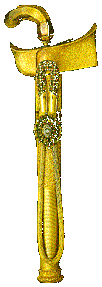|
The Keris is a mystical weapon, Malay people believe it is inhabited by a spirit, and the choice of a good Keris goes with a thorough knowledge of the power, the magic and the wealth of each pamor and dapur to match your personality and needs. Some keris are transmitted from generation to generation as pusaka (heirlooms). As
westerners, we are not strong believers in the magical power of the Keris, This study will attempt to classify the various types of Keris strictly according to their physical aspects. Javanese experts will have a more esoteric approach and will classify Keris according to its Tangguh, Sepuh and wutuh. The Keris origin is a subject of controversial theories. The Keris History page is a tentative contribution to this debate. A primitive variation of the Keris called Sajen or Majapahit, often wrongly identified as a proto Keris, is in fact a talisman. The Keris is a unique thrusting dagger from the Malay world. It covers a geographical area which extends from Southern Thailand, to the Sunda Strait and from Sumatra to the Philippines Moro Land. Although each region has its particularities in terms of blade, hilt or sheath shape, there are four common denominator to make a Keris:
|
| A Keris region of origin can be identified by its hilt, sheath and blade. To know more about how to identify a Keris, go the page : Parts of a Keris. |
| There a seven major areas of Keris smith making, our collection has been sorted according to these regions. To see the collection, click on the following links : |

Pictures from this page are from "Court Arts of Indonesia"
The Keris was proclaimed by UNESCO, in 2005:
"Masterpiece of the Oral and Intangible Heritage of Humanity"
 The
Keris is the distinctive edged weapon of the Malay World. The origin of
the word is uncertain, see
The
Keris is the distinctive edged weapon of the Malay World. The origin of
the word is uncertain, see  however, one never knows... Wise collectors will have the Keris spend its first
night at home under the pillow: if the night is full of good dreams, keep it,
otherwise do not allow it to stay at home!
however, one never knows... Wise collectors will have the Keris spend its first
night at home under the pillow: if the night is full of good dreams, keep it,
otherwise do not allow it to stay at home!